Are you a tour or activity operator looking for a sustainable way to bring new bookings to your website?
SEO for tour operators (or search engine optimization) is an investment that can bring in huge amounts of exposure – and revenue – over the long-term. It also lets you reduce the amount that you’re spending on PPC.
However, as you’ll probably know, there’s a huge amount of information online about SEO in the travel industry. How do I deal choose the right keywords, optimize for different search results, and compete with OTAs?
In the following sections, we’re going to give away our agency’s tried-and-tested techniques for ranking tour operators and travel agents on Google. By the end, you’ll understand how mastering travel SEO can help your tour business, and you’ll be able apply these techniques to your search efforts and bring in the bookings that you want.
So, let’s start at the beginning!
What is SEO in tourism?
SEO – or search engine optimization – is the practice of positioning your tourism website to be visible for keywords on search engines. It’s a form of internet marketing for tourism, and it can be one of the most powerful drivers of traffic for tour operators.
This is important, because a staggering 90% of trip planning takes place online. Search is a crucial marketing channel for tour operators.
If you can claim your stake at the top of the search results page, you can potentially get a huge amount of eyes to your website from people who are booking a trip. And if you’ve chosen the right keywords, this traffic will convert into successful bookings.
Keywords, which are queries entered into Google by people at different stages of their vacation planning, are the basic unit of SEO.
Further reading: 12 Unique Ideas to Promote your Tourism Company
The aim of SEO is to craft useful pages on your website that answer those specific keyword queries, so that Google recognizes you as an authority on that subject and ranks you in the top spot.
If your page is original, authoritative and targets the keyword well, most of the hard work is done. You stand a good chance of ranking for that keyword.
Tourism SEO ranking factors
That’s not all, though. In order to maximize your chances of ranking for your chosen keywords, your website needs to adhere to a range of search quality guidelines. These things are called ranking factors.
There are lots of ranking factors. Some are more important than others. You don’t need to perfect all of them. That’s an important point, because SEO is more than just ‘ticking the boxes’.
The most important ranking factors for travel agents and tour operators are:
- Valuable, high-quality content: Your pages should provide value to your audience with insightful, carefully-planned content that addresses its chosen keyword, while adhering to on-page SEO best practices
- Off-page SEO: Building trust signals from around the internet, known as backlinks or citations, helps search engines to verify the authority of your site
- Technical SEO: You should aim for a fast, user-friendly website that works across all devices. It should also be structured in a way that makes sense, with good site architecture and an optimized sitemap
How much, and how effectively, your website carries out the above actions will determine how quickly you’ll be able to rank ⚡
How to create a tour SEO content strategy 🎯
We’re gonna let the cat out of the bag here: the most effective way for tour operators to drive more bookings through SEO is with a dedicated content strategy.
What does that mean, exactly? It means creating written, search-optimized content to match the keywords that your potential customers are searching for. The end goal of a written content strategy is to build trust with your audience, who then turn into customers for your tour or travel agency business.
After booking flights and hotels, travelers spend most of their planning time looking for tours and experiences in their destination. A content marketing strategy is the best way to position yourself as an expert and connect with these potential customers.
Related reading: how to do SEO for your hotel or accommodation
In fact, Google tells us that there are 8x more experience searches than air searches in the 12 weeks leading up to a trip. By turning your website into a hub of information on your destination, you capture those searchers in the trip planning stage, from where you can lead them down your marketing funnel to a successful reservation.
A basic SEO content marketing strategy for tour operators can be broken down into three main steps:
- Understand who your ideal clients are (this is your target audience)
- Find the keywords that your target audience would search when planning a vacation
- Plan and create expert, SEO-optimized content around those keywords
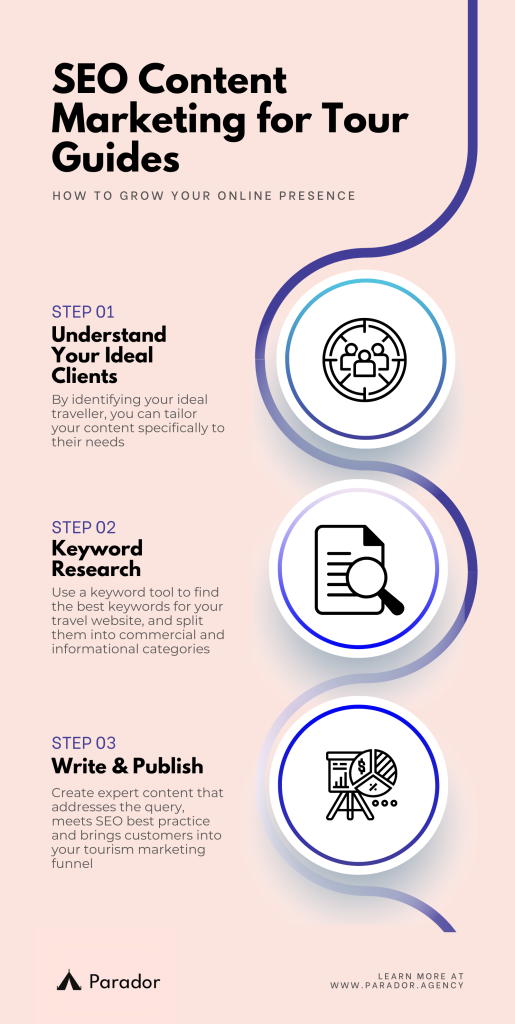
You might find it useful to refer back to this infographic as we go through each step in more detail.
Let’s dive deeper into the strategy.
Step 1: Profile your ideal clients 👥
In order to know what your clients are searching for, you first need to know your clients.
It’s important to first understand which type of tour operator you are, and then hone in on your target market.
For example, you might want to optimize your site for luxury travel, in which case you need to target an affluent audience with certain expectations from their tour provider.
Or, you might be an outbound tour operator targeting people who want to visit a specific destination.
The person with the most insight into your ideal client, however, is you. Grab a pen and paper and start sketching some persona profiles, each one corresponding to a type of client that you’d like to get bookings from. Ask yourself the following questions:
- Where are they from?
- How old are they?
- What are they interested in?
- What types of experiences are they looking for?
Let’s say we operate wine tours of the Bordeaux wine region in France. One of our ideal customer personas might be a British couple in their 40s, who want to arrange their own transport, such as a car or bike. They might also want to bring children or pets with them while traveling.
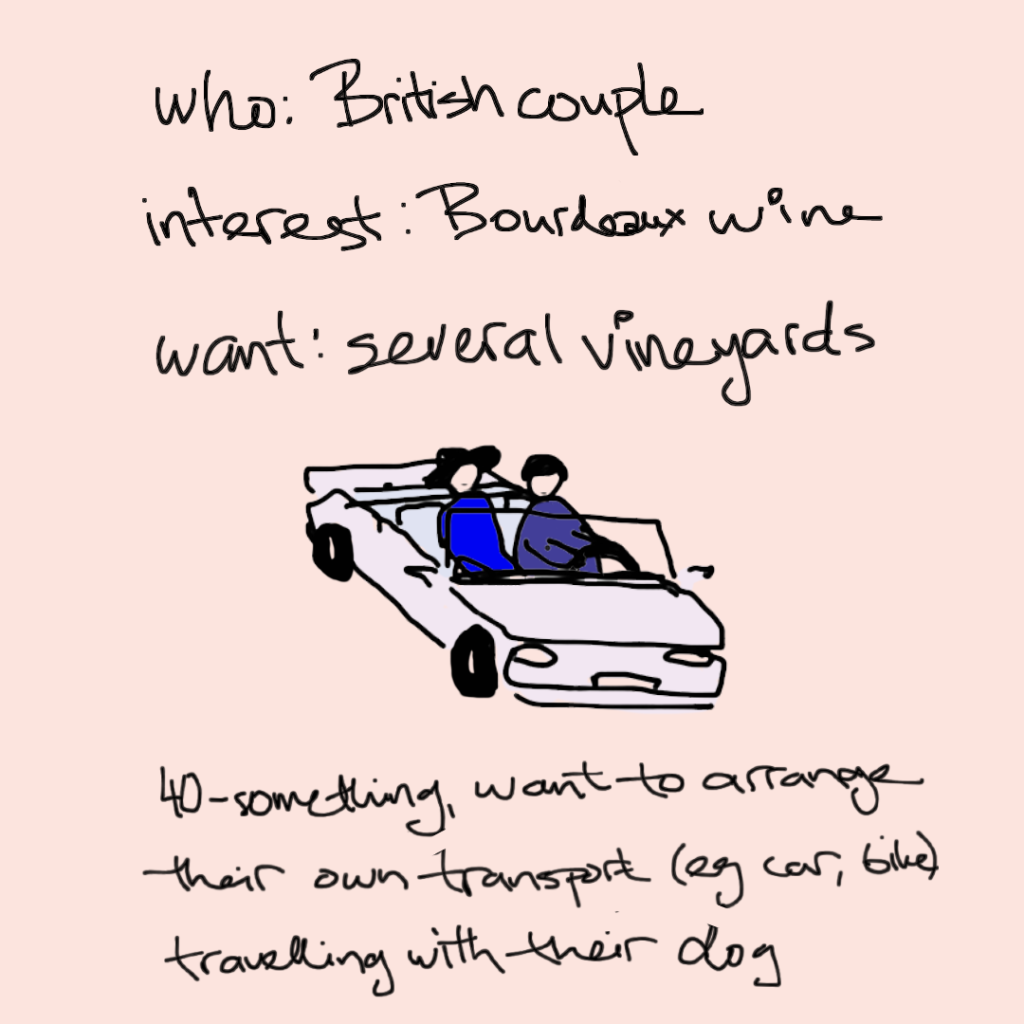
We’ll make a note of this and use it to guide our keyword research in the next step.
Remember: search engines always want to make it as easy as possible for users to get the best answers to their queries. A solid set of user personas will guide your keyword research and content production, so that you know sure you’re choosing the right keywords, and crafting the best possible content for your audience.
Step 2: Keyword research 🔎
The next step is to carry out research to find the keywords that your audience is searching. We’ve written an entire article on keyword research for tour operators, but we’ll go over the basics here, too.
There are many paid keyword research tools available, but we’re going to show you a highly effective way to do this using completely free tools.
When somebody types a query into Google, it’s called a keyword. For selling tours and experiences, we can split keywords into two types: commercial keywords and informational keywords.
Let’s look at the two types of keywords that will make up your content strategy:
Commercial keywords
Commercial intent keywords are keywords where the searcher already knows exactly what they’re looking for, and are likely to be ready to make a purchase.
For example, the keyword ‘private bordeaux wine tours’ has a strong commercial intent: you know the searcher is looking for private tours of the Bordeaux wine region in France, and is probably ready to book.
These types of keywords are your all-important revenue-drivers, and pages that target them will act as hub pages in your content strategy.
It’s good practice to limit the amount of commercial intent keywords that you create pages for, so as to focus your efforts on a strong set of offers and not spread your topical authority too thinly. Consider having a different page for each of your main products, and building out related informational pages from those (more on that next).
Informational keywords
Informational keywords, on the other hand, are keywords that support your main pages with related information around its topic. These are as important as your commercial intent keywords, because they provide an entry point to your website and marketing funnel.
Informational keywords should be related to the main topic, but they also need to be laser-focused on your user personas in the vacation planning stage, and the things they might be searching for in the run-up to that vacation. These pages don’t only boost your traffic: they are great for collecting emails, promoting special offers and gently guiding searchers towards a reservation.
For example, if you’d figured out that you want to target ‘private bordeaux wine tours’ as a priority commercial keyword for your business, you would then look for keywords related to ‘private bordeaux wine tours’ to write informational content about.
Having this mix of hub content and informational content on your website, backed up by proper internal linking, helps Google to understand that you are an authority on your topic. It creates what search engine marketers call a topic cluster of related pages. This is a kind of informational architecture that can give all related pages boost, including, critically, your revenue pages. More on that later!
How to find keywords for your target audience
So, the million dollar question: how do I know which keywords to target? The answer lies with your ideal customer. And to know what customers your keywords search, you need to put yourself in the shoes of your customer personas.
Head back to your notebook and write down a list of things which a potential client might type into Google when looking for a tour like yours:
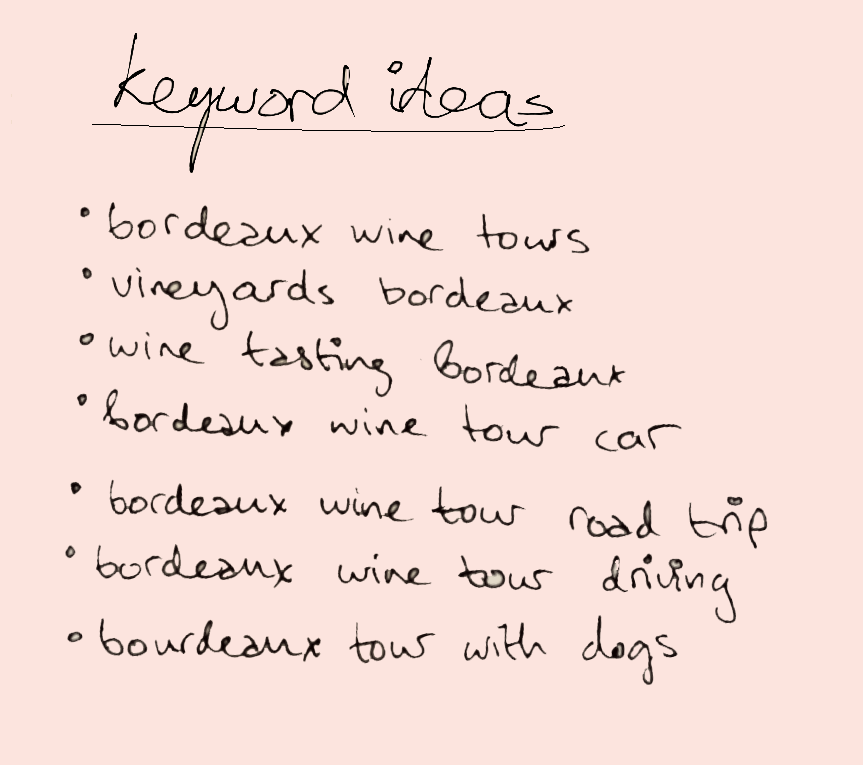
We’ve come up with seven possible queries that our ideal traveler might type into the search bar, based on their persona (mid-40s, want to arrange their own transport, might have pets with them). That should be enough for now. The queries are:
- bordeaux wine tours
- vineyards bordeaux
- wine tasting bordeaux
- bordeaux wine tour car
- bordeaux wine road trip
- bordeaux wine tour driving
- bordeaux wine tour with dogs
The next step is to translate our hypothetical keywords into real keywords that people use.
Open an incognito window (so that the results are objective, without taking your own search history into account), and input each of your raw ideas into individual Google searches, one-by-one.
Let’s take our first possible keyword, ‘bordeaux wine tours’. If you scroll to the bottom of the page, you’ll see a ‘related keywords’ section, which is a list of suggestions related to your original query.
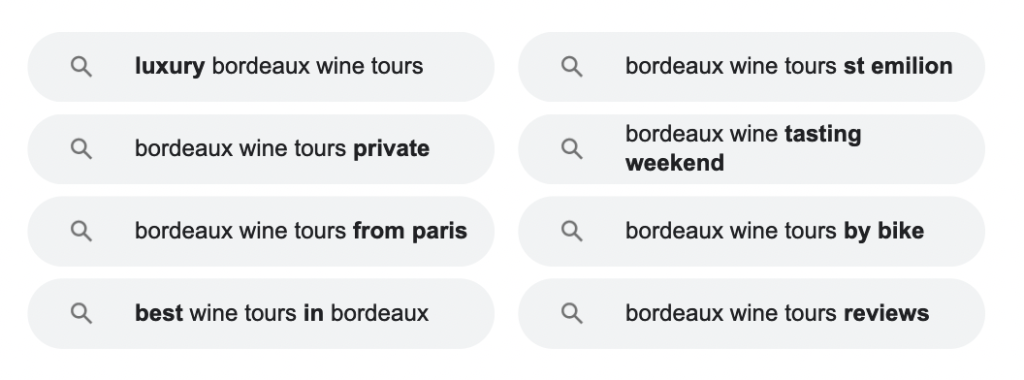
While we don’t know if ‘bordeaux wine tours’ is a real keyword, the related keywords section shows us keywords that people actually search on Google.
There are a few good ones here, but we can immediately spot one that is directly relevant to our target audience: ‘bordeaux wine tours by bike’.
We already know we want to target people who like to arrange their own transport, so this keyword looks like a safe bet. Make a note of it and carry on!
Looking back to those related keywords, you might wonder why we wouldn’t go for something like ‘best wine tours in bordeaux’, which seems to be a keyword that our target audience would definitely search.
The answer is simple: while our British couple might well search for ‘best wine tours in bordeaux’, so would everybody else looking for Bordeaux wine tours. We can assume, for now, that ‘best wine tours in bordeaux’ is going to be a highly competitive keyword, and much harder to rank for.
Secondly, because we’ve identified a different keyword that could fit perfectly with our target audience, who want to arrange their own transport, we are able to craft written content that speaks directly to our target audience.We will be competing in a lower competition space, which will increase the chance of a successful ranking, and therefore increases the chance of a booking. No-brainer, right?
Keep plowing through your brainstorming list, inputting each keyword into the search bar and making a note of any good keywords that Google throws up in the related keywords section.
You should also keep an eye on the autocomplete predictions box underneath the Google search bar. In the autocomplete box for ‘vineyards bordeaux’, for example, we can see another great keyword for our user persona, which is ‘vineyard bordeaux dogs’.
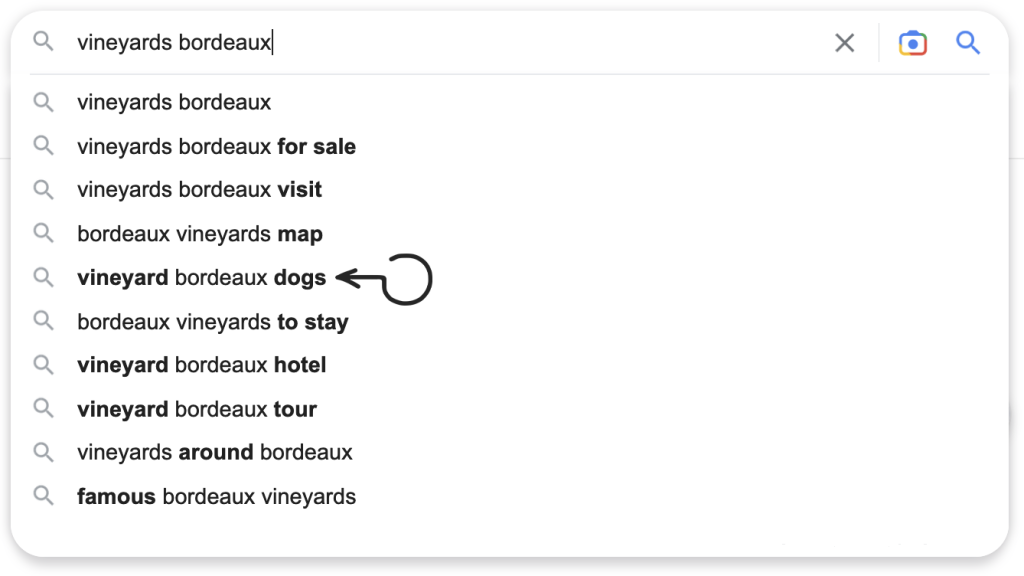
Get search volume data for your keywords
Once you have a list of Google-suggested keywords that you’re happy with, head to Google Keyword Planner, which is a free tool from Google that gives us insightful data on keywords.
Using a tool like Google Keyword Planner, we can find out whether our keywords are a good fit, or whether they’re too difficult for our website right now. We do this by looking at search volume and keyword difficulty.
Inside Google Keyword Planner, click ‘Get search volume and forecasts’, and type your chosen keywords into the box, one after the other.
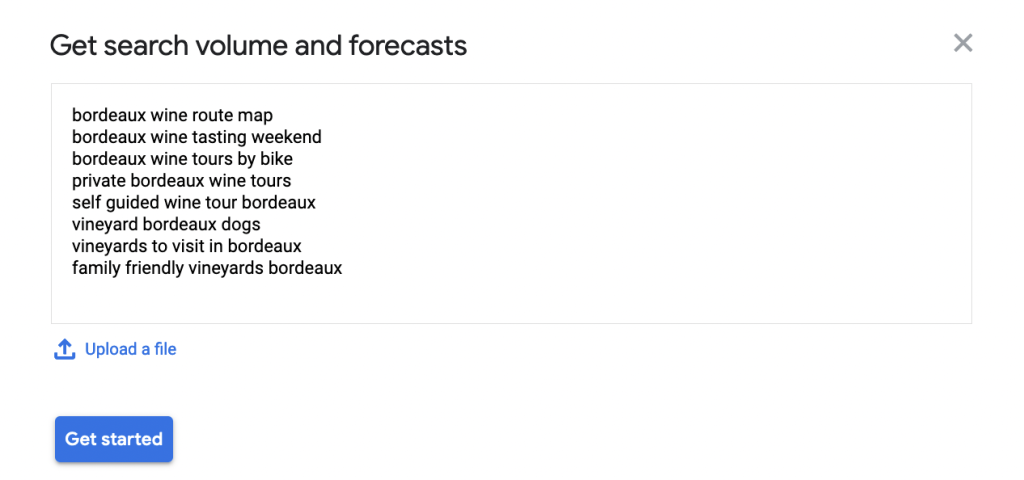
We’re going to assess the search volume, competition and CPC (cost-per-click) of these keywords.
- Search volume is the average number of times a keyword is searched per month. Keywords that have lower search volumes tend to be easier to rank for (and vice versa), but this isn’t always the case. We can also filter search volume by country, to understand which keywords are good for different target audiences globally.
- Competition, or keyword difficulty, is an indicator of how competitive the keyword is. Unlike search volumes, which are based on real data about how many people search a particular phrase, keyword difficulty is an arbitrary metric that tends to differ between different keyword tools. However, keyword difficulty scores can still give a good indication of how much effort you’ll need to put into a piece of content to make it rank for a certain keyword.
- CPC stands for cost-per-click, and represents how much it would cost, per click, if you were to pay for your page to be shown in the ads section of Google search for this keyword. Although we are dealing with SEO, not PPC, this data is still useful in determining whether a keyword has commercial intent or not.
Here are the results for our keywords:
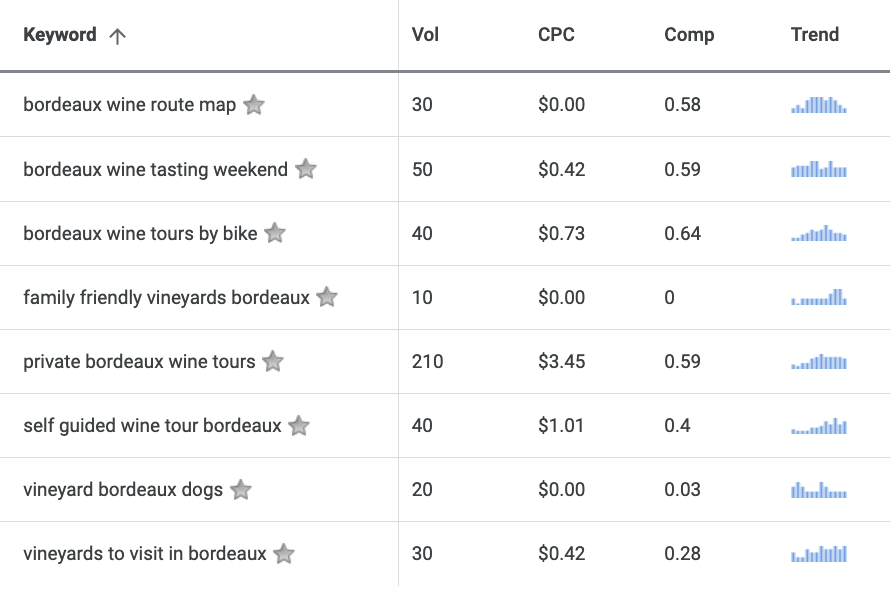
The first thing to look at is search volume: Google Keyword Planner tells us that ‘private bordeaux wine tours’ has 210 searches per month, which means a lot of potential traffic for pages that rank well.
This keyword also has the highest CPC in the list: if we were paying to display our site in the search results for this keyword, it would cost us $3.45 per click. From this data, we immediately know that ‘private bordeaux wine tours’ is a keyword that can bring revenue, because other tour guides are paying money to be displayed for it.
Let’s make a note that this is a commercial keyword, and then go back to our data.
The keyword with the next highest search volume is ‘bordeaux wine tasting weekend’. It has 50 searches a month, but its competition (0.59) is the same as our revenue keyword ‘private bordeaux wine tours’. I’d be inclined to skip this keyword, simply because of the effort required to rank compared to the potential benefit.
Once you’ve whittled down your list to a selection of keywords that you think are strong fit for your target audience, let’s split them up into our commercial keywords and informational keywords.
Open up a spreadsheet, and input your chosen keywords one-by-one. Take another look at the results page for each keyword, and make a note of the type of content that ranks.
Do you see lots of hub pages for direct bookings, or do the search results display more long-form, informational blog content? Categorize each keyword by their intent, and for each informational keyword, make a note of the commercial keyword that it’s attached to. Aim for at least 3-5 informational keywords per commercial keyword.
Organizing your content like this, with proper internal links between each page, creates a form of informational architecture that helps search engines to better categorize your pages, and the relationship between them.
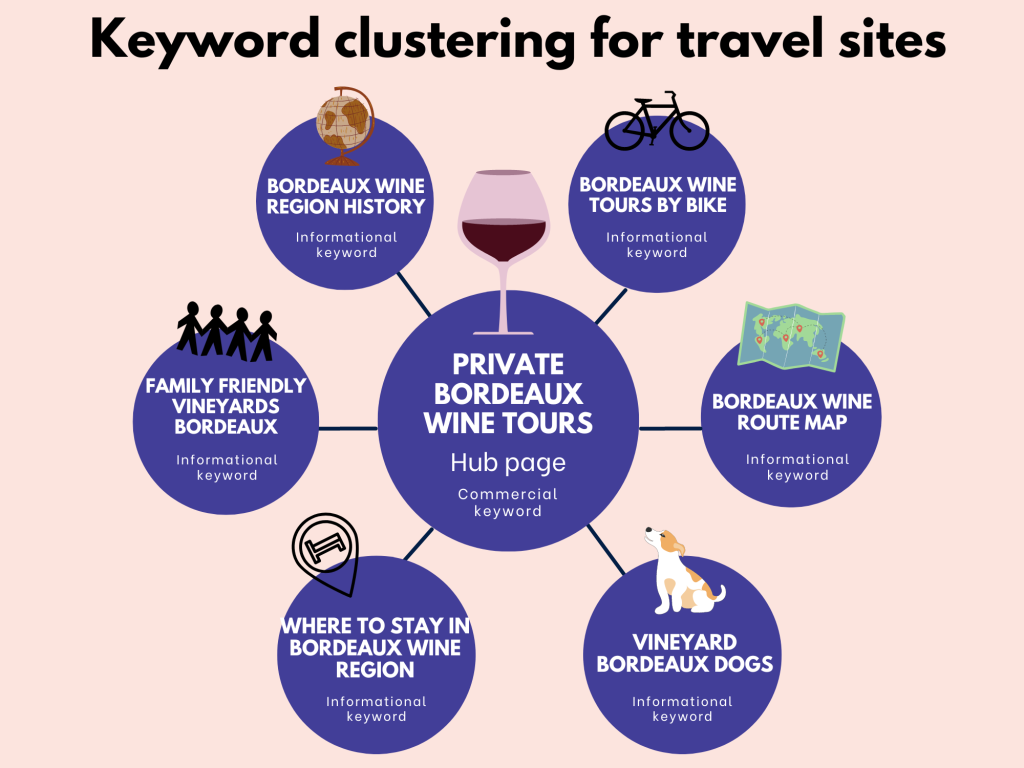
You can also enter the search volume, CPC and competition data from Google Keyword Planner into your spreadsheet, or any other keyword research tool you use, which can help you prioritize which keywords to target first. Once you’ve got a good selection of keywords, assign dates for writing and publication, and you’ve got yourself a tour guide SEO content calendar!
Step 3: Write and publish great SEO tour content ✍️
This is the fun bit! In this part, your local expertise and writing skills come together to produce expert written content that your target audience will love.
Google values helpful, trustworthy content created with humans in mind. We know this because of updates like the helpful content update, search guidelines like E-E-A-T, and previous changes to the way content is classified for search. The message always remains the same: Google likes authoritative content that is helpful to your users, shows trust, and speaks directly to the needs of your target audience.
First, look at your keyword, and think deeply about it. What does somebody who types this keyword into Google want to find out? Make a list of those things, and set out to answer all of them.
Next, look at the top 10 results for your keyword: what type of pages are ranking? How many words are they? What tone do they take? Do they include images, videos or maps? Note down all of these things, and make sure your content is as good as the top-ranking pages, if not better.
How to write tour landing pages
For your commercial keywords, your aim is to create a landing page that gives all the possible information about the specific tour you offer. This includes:
- A detailed itinerary of your offer, including highlights, stop-offs and duration
- Extra information about your location that only you can provide
- Available dates and accurate prices
- High-quality images that show your offer in the best light
- Details about the languages your tour is offered on
- Clear, easy to understand information about how to make a booking
- Details on the best way to contact you or your company
It’s also good to include an FAQ section which addresses the most common questions a potential booker might have. If you need inspiration for your FAQ, you can draw on the People Also Ask (PAA) section on the results page for your keyword.
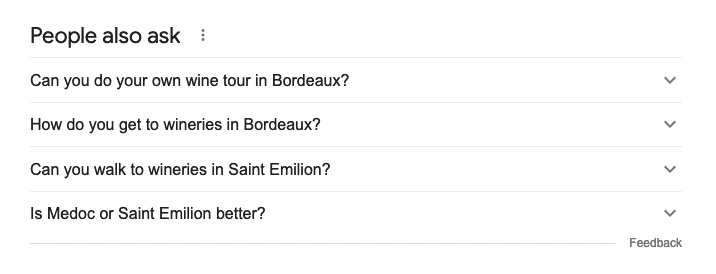
Another interesting avenue for tourism SEO is voice search. 40.2% of the US population now uses voice search to find information, so optimizing your landing pages for queries that a traveler might ask Alexa is not a bad idea. Think about what somebody might ask in a voice search when planning a trip such as the one you offer, and include it as a frequently asked question!
Finally, if you offer personalized trips or tours and you’re unsure of how you can provide so much specific information on a page, you can create a few sample itineraries which detail the different possible tours a client might create. This will give searchers an idea of the possible trips you offer, but also provide ‘spider food’ to the SEO crawlers to get a better sense of the content of your page, and its relevance to your keyword.
Expert tip: we see lots of websites hiding their tour landing page content in ‘tabs’, or ‘accordions’. This is a bad idea! While they might look nice, Google has a hard time reading tabs. Try to keep all of your written content in digestible sections with clear headings and subheadings.
How to write great informational (blog) content
Unlike commercial searchers, people who search for informational keywords are not usually ready to book. They are still researching the best experience for them, and the role of informational content is to guide them towards your offer through expertise.
Searchers are usually looking for long-form articles, whether this be a round-up of the best restaurants in your area, which hiking gear to bring on a mountain trek or the type of grapes grown in a specific winemaking region. You should use the knowledge you have about your location to deliver interesting, thought-provoking pieces that give the searcher exactly what they’re looking for.
Great informational content about your destination is evergreen, because the blog posts usually cover information that stays relevant for a long time.
This means that a good blog post can continue to deliver traffic many years after its initial publication, although it’s important to regularly refresh your content periodically to make sure it stays up to date.
It’s sobering to know that 54.4% of searchers click on a result in the top 3 positions. Being on the second page of Google is barely any use: SEO tends to be a winner-takes-all game, so your content needs to be up to scratch.
Your goal is to deliver the best article possible, that makes it as easy as possible for the user to find the information they’re looking for. You need to write compelling content that does justice to your business, and your specific expertise in the local sector.
Here are some best practices for top-class travel blog content:
- Go above and beyond: Weave in any extra valuable information you can give that competing content might not have; this should be expert knowledge that only you can provide. Travelers will have read the same regurgitated information over and over again, so differentiate yourself!
- Heading structure: Divide your writing into sections based on headings and subheadings, and make sure that your heading structure is hierarchical. This means you shouldn’t go directly from a section starting with a H1 to a section starting with a H3, for example.
- Internal linking: Create internal links to related posts on your website, with anchor text relevant to the target keyword of the linked page. It’s especially important to link between your commercial pages and any related informational pages to create a topic cluster, or ‘hub and spoke’ effect (see our infographic above), and it can be a pretty powerful technique for supercharging your search efforts
- External linking: Link outwards to authoritative sources around the internet (you can check whether a source is authoritative by using a free tool like Moz’s Domain Authority Checker)
- Images: Make use of original, high-quality images throughout your content, ensuring that they have appropriate alt text that describes the image well
- Lists: Use of bulleted and numbered lists like this one to split up and categorize information. If it can be listed, list it!
- Answer questions: Include key questions as headings, and give direct, thoughtful answers to the questions in the body text. You can take these questions from the PAA (People Also Ask) section on the Google search results page
- Engaging copy: Write in short paragraphs and snappy sentences to keep people scrolling and engaged. People say that dwell time is a ranking factor (we’re not sure about that), but everyone agrees that it’s good content is engaging
Make sure to also include relevant CTAs (calls-to-action) within your content, whether that’s for direct bookings or email signups, or anything else you might be using to get bookings from website visitors.
Of course, all of this content can then be repurposed in newsletters to your email list, as infographics or even as podcast episodes, should you wish to pursue those marketing channels. But if you want to target search, writing amazing blog posts on evergreen topics connected to your main services is the best way to bring traffic for the long-haul.
If you’re able to whip up high quality content that provides value to your users, then you have nailed down the most important rule about SEO for tourism: it’s not really about the search engines, it’s about the users.
We hope you have fun creating your content marketing strategy!
Section summary: a well-planned SEO content strategy is the most effective way to drive bookings to your tour offering in the long-term. See our dedicated travel content marketing services for more information on how you can supercharge your bookings with an expert-led content marketing strategy.
Unpacking the SERP: title tags, meta descriptions and rich snippets
Now that you have strong written content based around keywords, it’s time to look at the search engine results page, or SERP.
When we look at the organic results from a Google search, we notice three main elements: the page title, URL and meta description. Together, they form a search snippet.

Not all of these elements are direct ranking factors, but they do influence the decision on whether to click on your result. And, best of all, we have control over each section of the snippet.
It’s important to define these elements for all of your pages, especially your main tour pages. Let’s run through how to deal with each of them.
Page titles
Your page title is self-explanatory: it’s the title of your page. It might sound obvious, but it’s important to make sure your page title reflects the contents of your page and is relevant to the keyword it targets. It also needs to be something that makes the user want to click through to your result.
Page titles are one of the factors used by search engines to determine whether to show your page for a specific keyword; keep that in mind when writing title tags for your pages.
URLs
While the URL – the unique address – of your page is not a major ranking factor, it does show up in the search results. With that in mind, URLs should be short, snappy and relevant to the keyword. It should make somebody want to click on it; a high click-through rate (CTR) is an indication of the quality of your page, which can indirectly lead to better rankings.
It’s also a good idea to have a solid URL structure in place, with a short path back to the homepage. This is especially important in the travel industry, where websites often have numerous landing pages for each of their services.
Likewise, some booking sites have filterable search pages, which might result in numerous lengthy URLs. Have a look through the URL structure guidelines from Google to see how best to approach the URLs for your site.
Meta descriptions
The meta description is the descriptive text that shows up underneath the title in the search engine snippet. Meta descriptions are not a ranking factor, but they do provide an opportunity to differentiate your page from others, so it’s important to use the space provided to briefly summarize your page and encourage users to click.
As with URLs, good meta descriptions will bring in more clicks, which can increase your CTR. Search engines use this metric to evaluate the quality of your page, so try to keep your meta description short, engaging and relevant to your keyword.
Rich snippets
While snippets are the previews of search results that show up on the search engine results page (this is the standard URL, title and meta description), rich snippets provide extra data about the contents of your web page, such as reviews, prices and dates of specific tours.

Getting your page to show for rich snippets involves using a type of microdata called schema markup, or structured data. This is the language that search engines use to understand and categorize certain entities on your website.
Proper schema markup helps Google to understand that certain information on your page is connected to tour dates or ratings, for example, and then display that information in a rich snippet.

While rich snippets allow searchers to get more relevant information about a result directly from the results page, they also allow websites to take up more of that all-important real estate on the SERPs.
Travel and tourism websites can make use of the trip schema, which allows you to define certain elements of a trip itinerary, such as locations, dates and timings. If you want to implement this on your site, check out Google’s guidelines on structured data, or enlist the help of an experienced SEO professional.
Once you’ve implemented schema markup on your page, you can preview how it will look in the search results pages using Google’s Rich Results Test.
Having structured data isn’t a ranking factor, but it will allow Google to better understand your offer in comparison to other offers around the web. Rich snippets can also increase your CTR by making your listing stand out from others on the search results.
Section summary: the search engine results page is the SEO battleground, and you have control over the way searchers see your listing. Optimize your page title, URL and meta description for keyword relevancy and click-through rate, and implement tour-specific markup schema to display your tours for rich snippets.
How to nail local SEO for tours 📍
You’ve probably heard a lot about Google Business Profiles, local SEO and the map pack. And for good reason.
Local SEO is a wildly valuable marketing channel for tour operators; in fact, Google tells us that 48% of travelers are looking for experiences once they arrive at their destination. That’s a whole lot of receptive travelers in your local area!
Let’s break down the local SEO process with a quick example:
Sophie is on holiday in Budapest, and she quite fancies doing a river cruise along the Danube. Naturally, Sophie goes to Google and types something like ‘river cruise budapest’. The following map appears:
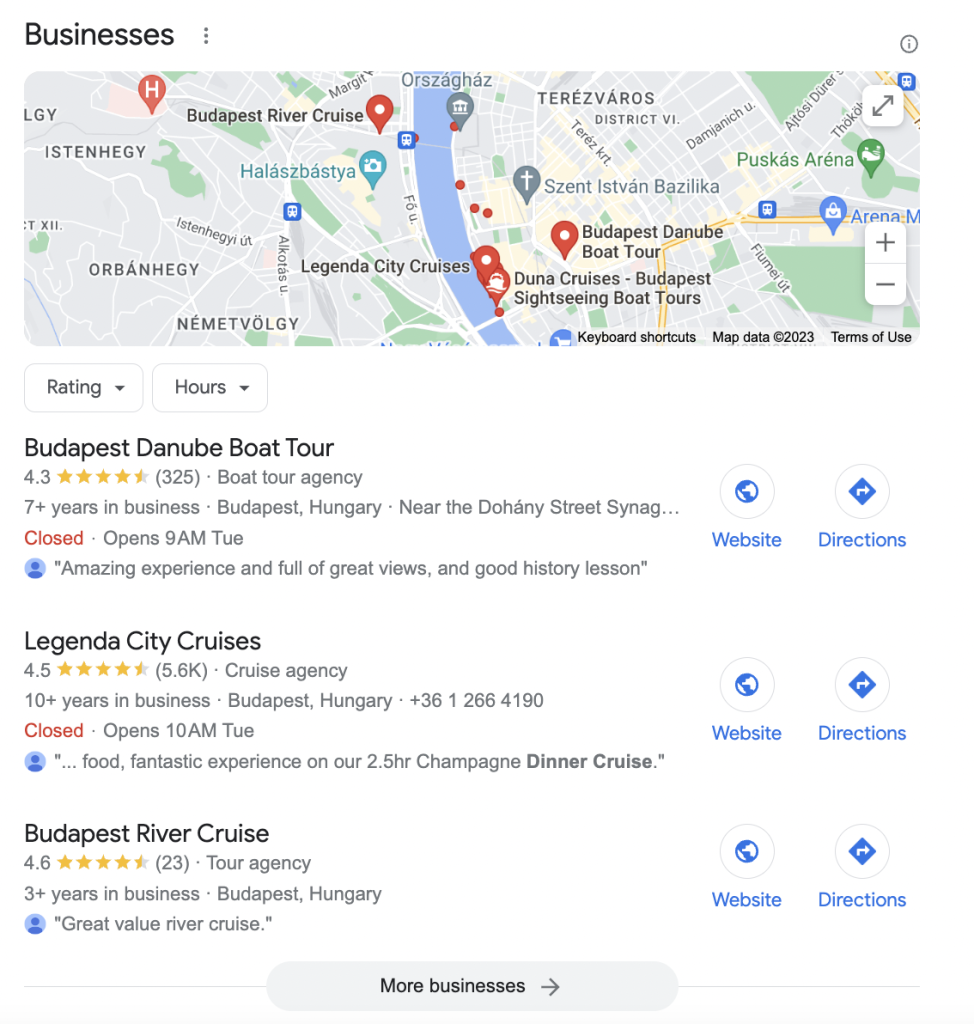
This is called the map pack, and getting your Google Business Profile into this map pack is the end goal of your local SEO efforts.
The map pack is a huge driver of business for tour guides, not least because the huge online travel agents can’t compete in the map pack. While OTAs tend to dominate a lot of organic search, the map pack is one place they can’t reach, because OTAs are not local businesses.
A local keyword for tourism will usually start with an activity, followed by a location, like ‘river cruise budapest’. Google increasingly returns the map pack in the results for these keywords, with the map pack showing relevant local businesses that offer services applicable to the keyword.
Queries that include ‘near me’ are also considered local keywords. The Google travel team says that searches for ‘unique things to do near me’ have grown globally by over 100% YOY, which is huge.
So, how do you use local SEO to get your travel business to show on the map pack?
Contrary to what you might think, local SEO can be quite simple. It basically comes down to four main tasks:
- Set up and optimize your Google Business Profile
- Build up a portfolio of reviews
- Build citations across the internet
- Include local information on your website
Let’s dive into each of these tasks.
1. Optimize your Google Business Profile
First things first: without a Google Business Profile, your business won’t get into the map pack. So head over to Google and add or claim your profile.
You might consider using a location name within your business name for added local relevancy (if you do this, it’s important that all other mentions of your business on the internet do the same: more on that later).
The next step is to verify your business with Google. This is usually a straightforward process, but it might take a couple of days for your listing to be approved.
Once you’re verified, you can start inputting your business categories and information. You can choose the ‘tour operator’ category, or you could choose a combination of categories that best describe your business. If you’re unsure which category to choose, have a look at the categories that other businesses who rank in the top 3 for your local keyword use.
It’s important to give as much information as possible about your operations within your Google Business Profile. Google’s mission is to be the most trusted resource for travelers to find the most useful information and make fast, effortless decisions. They want to help users find exactly what they’re looking for, quickly.
If you’re feeding Google with every bit of data that there is about your business operations, you increase the chances that your tour will be displayed for a relevant query. For that confidence you bestow, Google will reward you. This is the key to local search success!
Examples of information for tour SEO you should give include:
- Exact location: customers need to be able to find you, so it’s critical to include your location or service area (if you operate a service area business)
- Opening hours: show which hours you operate and update them regularly with any changes
- Description of tour activities: this should be a short, persuasive description of your services, which includes the local keywords you want to target (used naturally!)
- High-quality graphics: high-quality photos and videos showcase your services, and help travelers to get a better sense of what to expect from your tour
- Ticket prices and booking links: Google have added ticket booking link sections to the knowledge panel for top museums and attractions, which allows customers to book directly through search.
At the moment, this is limited to certain attractions and tours related to those attractions, but it will soon be rolled out to all tour operators. When this happens, you’ll be able to update your ticket prices in real time through the Ticket Editor in your Google Business Profile to make the most of this powerful feature!
The job doesn’t finish there, though: once all your business information is filled out, it’s paramount that you keep it extremely up-to-date.
Have you implemented disabled accessibility on your tours? Add that information to your Google Business Profile. Taking next Monday off? Update your Google Business Profile. Google rewards accuracy and honesty, so try your best to keep up. Again, it’s not only Google that will reward you here; your customers will thank you too.
2. Collect 5-star reviews
The next thing you want to do on your business profile is to start collecting reviews.
Whether or not a tour operator has good reviews does play into the ranking factors for local search terms; the more good reviews a tour operator has, the more Google will trust it, which will influence your position in the map pack for local keywords.
Encouraging reviews is notoriously hard for many brick-and-mortar businesses, where the majority of transactions take place in a physical space.
As a tour operator, however, you have a few unique opportunities to build up a portfolio of great reviews from your customers:
- Reminders: tours are often highly scripted, so include a part in the tour to remind customers to leave a review if they are enjoying the experience. Reminding customers at the beginning, middle and end of the tour will keep the idea in their minds, and increase the chances of them leaving a review
- Printed material: If you supply leaflets, brochures or printed handouts as part of your tour, you can easily include details of online platforms where your tour businesses is listed, and encourage reviews that way
- Follow-up emails: follow-up emails can be used to ask customers if they enjoyed the tour, and to ask for a review on Google! You can also use CRM software to carry out this task automatically
- Be personal: people love personalization, so try and create a connection with your customers. Simple things like remembering peoples names and interests can go a long way in building a good online reputation!
Good reviews are one of the strongest indicators of quality in the consumer mindset; 95% of travellers read the reviews before booking. Reviews are important for your entire bottom line, not just SEO.
3. Build local citations
Citations are used by search engines as yet another measure of the trustworthiness of your business, and they’re a big deal for local SEO.
In essence, the more mentions of your business search engines find around the internet, the more it trusts you as an actual, credible business. And, as you’ll know by now, more trust = better rankings 🤞
So, how do you build citations?
The answer is business listings and directories.
Your Google Business Profile is a business listing, but there’s also Tripadvisor, Facebook, Bing Places, Yelp, Apple Maps, and countless more.
You want to get your business listed in as many of these major directories as you can. When you’ve done that, start honing in on the more specific directories for your tour business: tourist board websites, DMOs, travel agent listings, adventure sport directories, local history sites – whatever it is that offers a listing that could be relevant to you.
Finally, while OTAs do take a commission on bookings, they are also highly trusted business directories. Having a presence on a range of OTAs will be beneficial for your local SEO, since they help Google to verify the authenticity of your business.
NAP consistency
The key to successful citation building is NAP (name, address and phone number) consistency.
This basically means ensuring that your business details are an exact match across the directories you submit to. So, if you’re listed as Helena’s Hot Air Balloons on your Google Business Profile, make sure that you’re Helena’s Hot Air Balloons everywhere. Search engines value consistent information, because it helps them to build up a reliable picture of your business.
When I build citations, I make sure to have the business details in question open in a note on my desktop. This lets mecopy and paste each line of information, word-for-word, as I submit to each directory. Do also keep a note of which directories you’ve applied to: if any of your business details change, it’s good to know where you’re listed, so you can easily go through and edit each of your listings.
4. Include local information on your website
While the map pack dominates on local keywords, there are still good old fashioned organic results, too, and you should be targeting them. The way to do this is to include lots of local information on your pages.
If you followed the keyword research guide above, you will probably already have a set of local keywords to target. The trick here is to make sure those pages act as informational hubs on your location, and the activity you offer in your location. You can do this on the page itself, but also by linking out to other resources on your site that offer further, related information on your topic.
Creating these kinds of local hub pages has a double effect: not only can these pages show up in the organic results for local keywords, but organic results are a ranking factor for local SEO for tour operators.
In a nutshell, the more local relevance Google attributes to your website, the more likely it is to reward you in the map pack. So, if you have a page ranking organically about your tour in your location, that will increase the chances that your Google Business Profile will also show up in the top three businesses in the map pack. It’s a virtuous cycle!
By supplying detailed information, collecting positive reviews, building consistent citations across the internet and making sure your pages are well-optimised for local keywords, you increase the chances of appearing in the map pack for searches related to your tour business. This can be an extremely lucrative sales driver, and one that you should pay a lot of attention to as part of your wider SEO efforts.
Section summary: local presence is what makes your business different from an aggregator or OTA. Effective local SEO is an extremely powerful driver of traffic for tour operators, but it requires a long-term commitment to optimizing your Google Business Profile, building relevant citations and maintaining strong reviews.
Technical SEO for tour operators
Even after you put all of the above tips into practice, have a best-in-class content strategy and dominate local SEO, it’s proper technical SEO that will separate the very best from the rest.
Technical SEO involves making sure that your website is technically proficient from both a search engine and user perspective. Is a search engine crawler able to easily access your website, categorize your content, and understand your subject matter? Is your website equally accessible on desktop, mobile and tablet?
You might have the best SEO content strategy in the world, but if search engine crawlers have a hard time accessing your content then they will prioritize someone else’s site in the rankings. In the worst case scenario, they might not index your site at all 😱
Technical SEO is something that should be at the back of your mind all the time. Here are some best technical SEO practices for tour operators to keep on top of when working on your site:
- Keep important content visible: your most important pages shouldn’t be hidden within directories and subdirectories: they should be accessible within a maximum of 2 clicks from your homepage. This is called click depth, and it’s important to keep the click depth low between your homepage and your main tour pages.
A low click depth for your main pages will help search engines prioritize the most important pages, but it will also help keep bounce rate low (bounce rate is the percentage of users who click away from your page, because they can’t find the information they need), which is another ranking factor Google takes into account.
- Structure your site well: your site navigation and architecture should be easy to understand, both for crawlers and users. Keep pages and post categories to the bare minimum, and make sure every post or page is accounted for within a directory that makes sense. Your users will thank you for it!
You should also make sure that you don’t have any broken links on your site, which lead to a 404 error. 404s mean bad user experience, which negatively affects the ‘value’ of your site. They also can’t be indexed by search engines, which wastes some of your crawl budget. In short avoid 404s!
- Keep URL slugs short and relevant to the keyword: nobody wants to read a URL that looks like mytours.com/blog/2023/best_river_cruises_complete_guide_2023
They want something short and simple, like mysite.comblog/best-river-cruises. Your URL should indicate what your page is about from a glance, and how it fits into your larger website structure.
- Avoid duplicate content: one of the biggest no-no’s for technical SEO is duplicate content. When two pieces of content are similar or identical, Google has a hard time knowing which one to rank. This often results in a lower ranking for both (or all) pages.
This is called keyword cannibalization, and it tends to happen when two pages target the same keyword. Make sure to clearly differentiate your pages, and use canonical tags if you need to designate which page has the most importance.
- Image alt text and file names: all images on your site should be tagged with relevant alt text, which is the text that search engines use to make images more accessible. Good alt text needs to describe what’s happening in the image succinctly, while still giving the important details.
For extra SEO magic, you can also weave keywords into your alt text – but make sure you do it naturally. It’s also a good idea make your image file names relevant to the image, rather than something generic like ‘DS0021.jpeg’.
- SSL certificate: an SSL certificate is vital for your site security, and it acts as a certificate of trust. It’s good for user experience, and it’s especially important if you accepting online payments for your tours directly from your website.
Even if you follow all these best practices, it’s likely that you’ll run into technical SEO problems at some point, especially as your site grows.
The best way to spot technical SEO problems on your website is with a free site crawler like Screaming Frog.
You can use the free version of Screaming Frog to crawl up to 500 URLs at a time. If your site is particularly large, you might consider upgrading to the paid version, but the free version should suffice for most small-to-medium sized travel websites.
Download and install Screaming Frog, input your URL and wait for the crawler to run. It will come back with a list of potential errors on your website, which you can filter by incidence and category.
Screaming Frog is great for getting into the nitty-gritty of technical errors on your site, so it’s worth carrying out an audit at regular intervals to make sure there’s nothing holding back your tour site’s SEO performance.
Another place you can spot technical problems on your site is within the Google Search Console error report. This report gives details on common problems like non-indexed pages, redirects and mobile usability.
You don’t need to check your website everyday, but it’s a good idea to keep an eye on them and jump on top of any technical SEO problems when they arise to prevent more problems later down the line.
For complete peace of mind in knowing that your website is operating at its full potential, you can reach out to a qualified travel SEO service like Parador for a full-site travel SEO audit to uncover problems with your site and make sure you are achieving your best results from search.
Page speed and core web vitals
Core Web Vitals are a measure of how well your website performs a certain set of operations, including how each page on your site loads, both on mobile and desktop.
Google has been giving more and more emphasis to core web vitals as a ranking factor in recent years, so we consider it extremely important to score as highly as possible on the core web vitals test.
You can check Google Search Console to get Core Web Vitals reports for your website. For a more in-depth report, use Google’s PageSpeed Insights tool to check your overall core web vitals on both desktop and mobile.
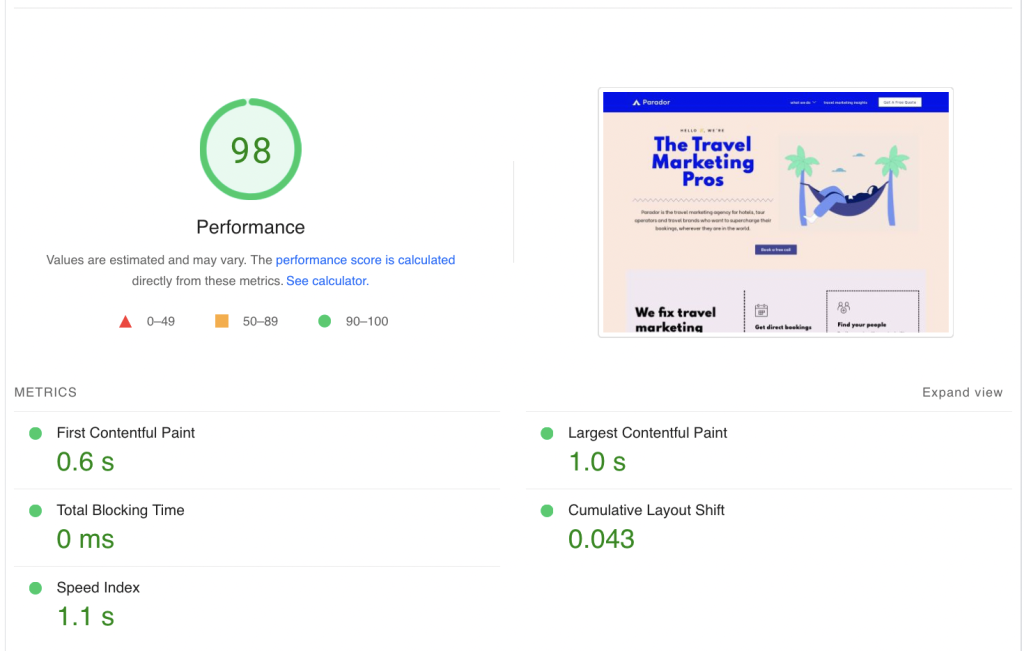
The page speed report will also give you actionable tips on how to improve specific areas, such as:
- Largest Contentful Paint: this web vital metric measures how long it takes your page to fully load from a user’s perspective. A similar metric with slightly less importance is First Contentful Paint, which is how long it takes for the first element of your page to load
- First Input Delay: first input delay measures how long it takes for your site to become interactive. In other words, how long does it take for a user to make an interaction with your page? This isn’t included in the PageSpeed Insights report, but it does form part of your Core Web Vitals
- Cumulative Layout Shift: this metric measures how much and how often your page visually ‘shifts’ before settling into its proper format. An ideal score is 0.1 and below, although this can be hard to maintain for travel sites, which often contain lots of large, visual elements
Here are some ways to improve your core web vitals:
- If you’re using WordPress, download an optimizer plugin like WP Rocket to help you achieve compliancy on the Core Web Vitals test. Custom-built websites will need the help of a developer to make the necessary fixes to increase your PageSpeed score
- Your hosting can have a big effect on your page speed: if you’re using shared hosting for your website, consider upgrading to a dedicated or managed plan
- Remember to resize and compress your images, and use next-gen formats like WebP. This decreases server resources and can help increase page load time
- Serve your website through a content delivery network with a caching solution like Cloudflare
Optimize your site for mobile
Mobile optimized is now paramount to your SEO efforts. Mobile started to overtake desktop searches in 2019, and mobile-first has been a key concern for search engines since.
Add this to the fact that the vast majority of in-destination searches (searches made when somebody has already arrived at their destination) for travel keywords will be made on mobile, then having your site perform flawlessly on mobile should be a top priority.
Google will look at the mobile version of your pages when it crawls through your site. With that in mind, be sure to apply any technical fixes to both your desktop and mobile site, and make sure all your content is actually published on mobile. If Google finds less content on your mobile site than on your desktop site, you might even experience a drop in rankings 👎
Mobile is the way to go!
Section summary: Good technical SEO is what makes your website indexable, and without it, the rest of your SEO efforts will be in vain. Make sure your site is simple, navigable and fast, and that it works seamlessly across all devices. Dealing with technical SEO issues as and when they arise is the best way to keep on top of them.
Off-page SEO for travel and tourism
Off-page SEO refers to all the actions taken away from your website that help build authority signals towards it.
This essentially means building backlinks, which are like ‘votes of confidence’ from other websites, in the form of links, to your website.
Despite signs that Google might be shifting away from backlinks as a major ranking factor, they remain important as of 2024, especially for tour guides operating in competitive search landscapes.
Each backlink you gain will help to build up the authority of your website, and specifically of the page that is linked to, which, in turn, will help with rankings. And the more authoritative the website that you get a backlink from, the more prestige is passed over to you.
The challenge for tour guides is in gaining high-quality backlinks while staying within Google’s guidelines. Links should be acquired naturally, and you definitely shouldn’t pay anybody for them. This is against Google’s guidelines, and besides, everybody knows that paid links are hardly likely to give you any benefit.
Backlinks are notoriously hard to get, but we know a few tricks to help travel brands win in this field. Here are three of our favourite ways to build backlinks for travel agents and tour guides:
1. Guest post on travel blogs
There are thousands of travel bloggers and dedicated travel websites on the internet.
As someone working in the tourism industry, you possess valuable insights into your destination, and there are tons of websites that would be happy for you to share that knowledge with their audience.
Guest posting is a way of sharing your knowledge or expertise with somebody else’s audience. In return, most guest posts will include a link to your website. It’s basically a form of friendly PR.
To find relevant opportunities for guest posting in the travel industry, you could start with some refined web searches related to your topic. If you have a luxury travel brand, try type “guest posts” “luxury travel” in Google. This will return a list of websites which contain both of those terms.
Once you have a list of potential websites for guest posting, use a tool like Moz to get the DA (Domain Authority) of each website. The higher the DA, the more ‘powerful’ the backlink you’ll get from having a guest post on that site.
Start drafting up emails to your potential guest posting sites, one-by-one. It’s best to come with an idea for a guest post already formed, which draws on your specific expertise and is tailored to the site you’re applying for. What does their audience look like? What topics have other guests covered? How does it tie in with your own knowledge?
Craft an proposal for each site on a one-by-one basis, and try to deliver an offer that provides value to their audience.
2. Reach out to local tourist boards
Not all links are created equal. Backlinks from higher authority sites will help to pass on more ‘juice’ to your pages, and businesses catering to the tourism industry have a unique opportunity to gather these high quality links: the local tourist board.
Tourist board and DMO websites tend to be ‘high authority’ sites; in fact, some tourist board websites might even use ‘official’ top-level domains such as .gov, which are considered to be some of the most powerful subdomains to gain backlinks from.
Because most tourist board websites will have a dedicated page or directory for local activities, events and attractions, tour operators have a chance to be featured on these types of pages with a link back to their own site.
A simple, polite email that reads something like the following is an excellent way to strike up conversation:
Dear Tourist Board.
Pitching to the tourist board
My name is x, a tour operator specializing in bespoke street food tours in x city.
While browsing your website, I noticed that you have a helpful listings page for businesses in the local area. As a local tour operator, we feel that our service is well-placed to represent the street food scene in the city, and could be of interest to visitors to your site. Would you consider featuring our business as part of your listing?
Kind regards,
Tour Operator
You can also utilize local contacts like hotels, attractions and other businesses serving tourists, and see whether they have a section on their website for local events and activities. If you run a travel agency, get in touch with your partners to see if they want to feature you on their website.
This kind of outreach is mutually beneficial to both parties: one side gets to make their listings more comprehensive, while the other side potentially gains a backlink and extra visibility for their tours.
Remember: asking for links is against the Google search quality guidelines, so don’t explicitly ask for links when reaching out. If your service adds genuine value to your destination, then it follows that you should be listed on the local websites; your interaction should come from this angle, rather than for purely SEO benefit.
3. Useful content (again)
Another benefit of a well-crafted tourism content strategy is that useful content will naturally bring in backlinks from around the web, because, well.. websites want to link to useful content!
The first step here is to think about what type of websites might be interested in linking to your site, and then to create helpful resources to meet their needs.
To maximize your chances of getting backlinks from your written content, you can:
- Write useful ‘best of’ and ‘how to’ content that people writing travel guides might reference and link back to
- Publish captivating infographics within your content that other sites will want to link to
- Include unique statistics about your destination that only somebody with your expertise can provide
- Find out which keywords journalists and publishers who are writing about your destination might be searching, and write content that caters to them. Backlinko calls this ‘reverse outreach’, and it can be a powerful way for travel and tourism brands to get backlinks from newspapers and publications
Most of all, if your content is thorough, well-researched and useful to your target audience, it will naturally start to pick up backlinks as other sites around the web reference it in their own content. This is a au naturel way of building up a backlink profile, which is our preferred method!
Section summary: Backlinks are considered one of the hardest areas of SEO to crack, but businesses in the travel industry have unique opportunities to build their presence around the web. Practice responsible link building through guest posting and outreach, and don’t try to buy or ask for backlinks in return for money.
Multilingual SEO for tourism
Not all Google searches are carried out in English, and businesses in the tourism industry are likely to have customers that speak a range of different languages. Don’t sleep on this opportunity: multilingual SEO opens your website up to new target markets.
If you offer culture tours in Rome and many of your clients are German-speaking, for example, then it is definitely not a bad idea to translate your main product and commercial pages into German and put them on a /de/ subfolder on your site.
A tool like Weglot is easy to set up for this purpose, and will help you to automatically translate your site, as well as deal with technical nuances such as hreflang tags and translating your metadata.
To make sure that all of your potential customers are able to find you on search, however, consider carrying out keyword research in the native languages that your clients tend to speak.
By finding keywords in your clients native language, you can find out what they might actually search when looking for experiences, and create multilingual pages for those keywords.
How to translate SEO keywords
The process for translating SEO keywords goes like this:
- Make a list of the most important keywords for your site
- Translate the keywords into your target language
- Check whether the translated keywords are worth targeting (search volume and competition)
- Do keyword localization to make sure you get the best translation that people actually search
This is where the language switcher feature on your keyword research tool comes in handy. In Google Keyword Planner, for example, you can set multiple languages and countries to check possible keywords against.
In the following example, I’ve changed the language to German and set my location to German-speaking countries, as well as Italy. This way, I can target countries where people are likely to be searching in German, as well as German-speaking travelers who are already within Italy, where my tours are located.
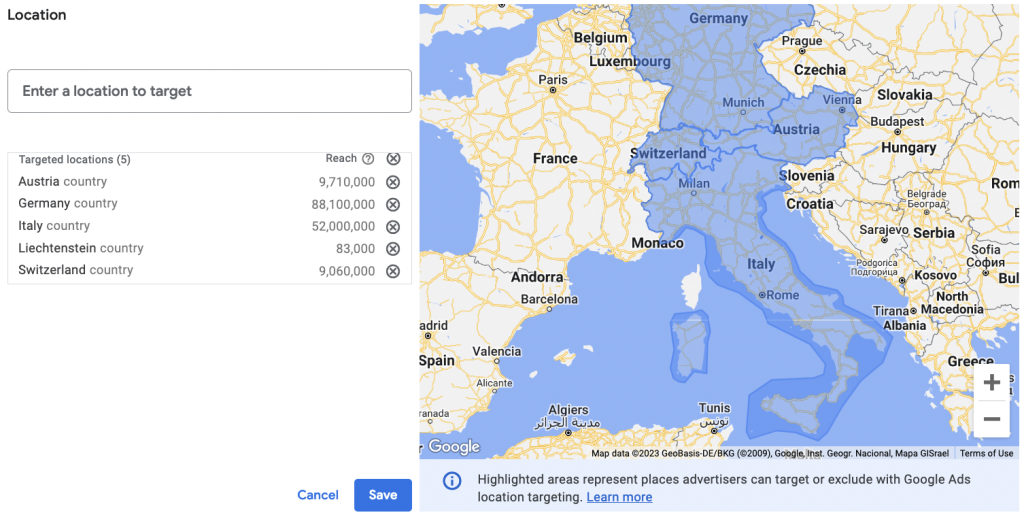
Let’s pretend that one of my most important keywords is ‘things to do in rome’, which has several thousand searches a month in English. Google Translate tells me that this literally translates to is ‘die besten aktivitäten in rom’ in German, so I’ll type this into the keyword planner with my new location settings:
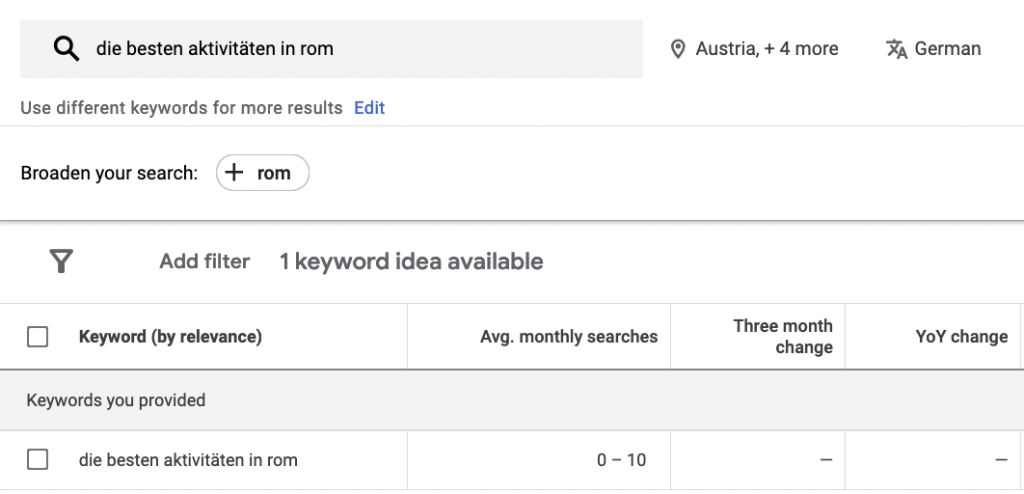
It looks like ‘things to do in rome’ doesn’t translate well into German: the keyword planner tells me that it barely picks up any searches.
In this instance, we need to move to the next step of the keyword translation process, which is localization.
Localizing keywords
You must be careful when you translate a list of keywords for your site, because audiences in different countries might use different, localized terms to search for the same thing.
In some cases, understanding how your keywords translate and localize into different languages may require the use of a dedicated translator or native speaker with a deep knowledge of the target language. There are, however, some ways in which we can surface similar or related translated keywords using Google itself.
Let’s throw our literal German keyword into a Google search and see what it suggests:
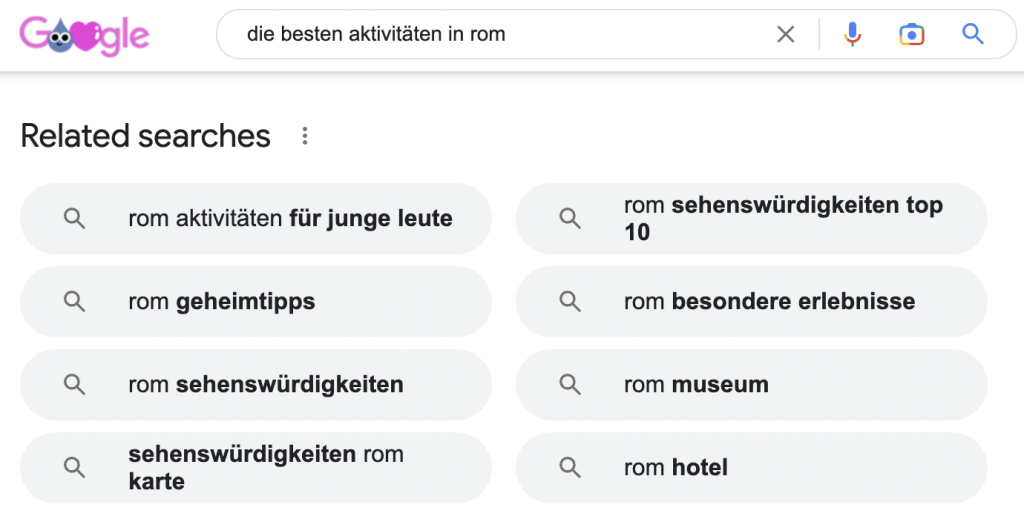
I don’t speak German, but I can see that these look like vaguely like searches for activities and experiences in Rome (if in doubt, you can use a browser extension to translate the entire page automatically).
Let’s go for ‘rom besondere erlebnisse’, and put that back through the keyword planner.

Success 🥳! This keyword, which roughly translates to ‘special experiences in Rome’, is low competition and has up to 100 searches a month. This puts us in a good position to compete, and we now know that the German language version of our ‘best things to do in Rome’ page should be optimized for a similar, but slightly different focus, which is ‘special experiences in Rome’.
Rinse and repeat!
Now that you understand the importance of localizing keywords for different languages, you can begin finding the most accurate versions of your most important keywords and creating translated pages for them. This will allow you to reach more travelers searching in their own native language, which can have a huge impact on the organic reach of your travel and tourism website. Cool, eh?
Section summary: Translating your website into the language of your customers increases your visibility and provides an advantage over competitors who don’t. However, not all keywords translate word-for-word, so translations need to be carried out with an understanding of the target language and market.
Conclusion: SEO drives bookings for tour operators
In a nutshell, a well-optimized travel or tour website needs to be useful to potential travelers and backed up by proper keyword research. We believe that great SEO is the sweet spot between your expertise and the needs of your potential customers; if you can get this right, search engines will reward you and the bookings will flow in.
We hope you’ve found this complete guide to SEO for tour operators useful, and that you now have some actionable steps that you can put into place to grow your organic traffic and bring more bookings for your tourism business.
Parador is available to help with any aspect of SEO content or local SEO for your travel or tourism website. We currently have a small amount of spaces for monthly SEO services – feel free to get in touch and we’ll get back to you as soon as possible.

